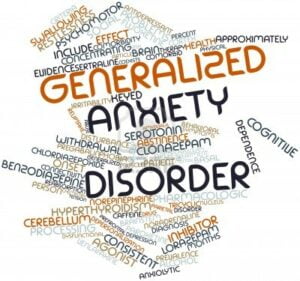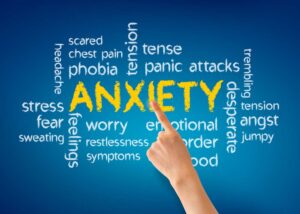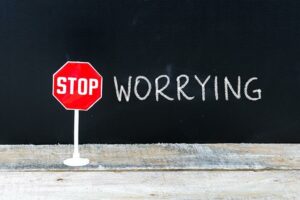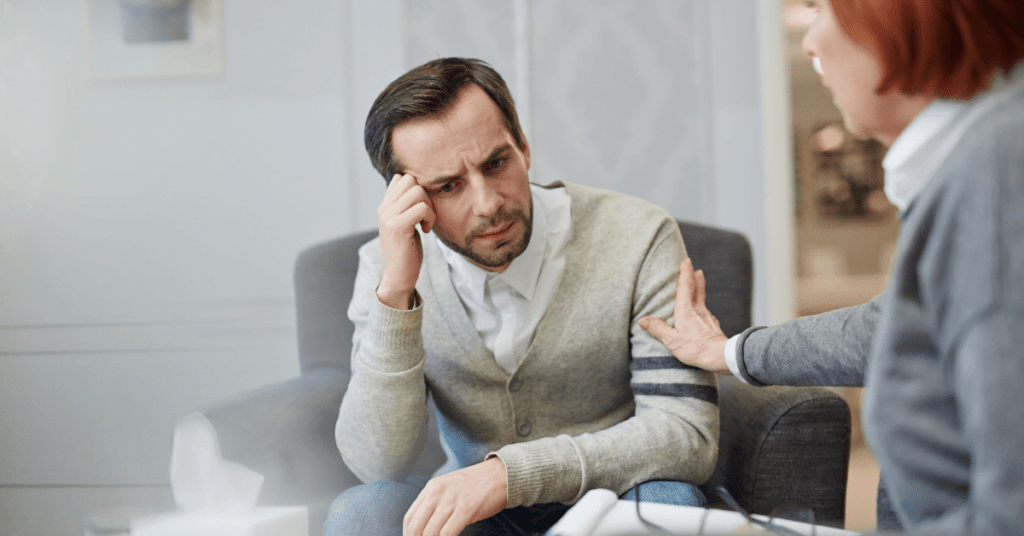Contents
Living With Anxiety

Anxiety is a feeling that can come and go without warning, or it can be something that we deal with on a daily basis. There are many things you can do to manage your anxiety such as staying focused, practicing mindfulness, and even learning how to meditate. You’ll want to learn more about how you can live with anxiety by reading this brief.
Living with anxiety can be one of the most difficult challenges you will ever face in your lifetime. It’s not like you choose to have it, or that you can simply wish it away.
What Is An Anxiety Disorder?
Anxiety disorders are a type of mental illness that causes the sufferer to experience extreme and irrational fear. Symptoms can include a pounding heart, nausea, dizziness, headaches, and being so tense or restless that it’s hard to sit still. This can be debilitating for those who have an anxiety disorder as it leads to lack of sleep, isolation from friends and family, and avoidance of certain situations. Luckily, there are treatments for this condition including medication as well as talking therapies such as Cognitive Behavioral Therapy or Dialectical Behavior Therapy. It’s important to understand that not everyone with anxiety needs treatment and often times just needs support from family and friends. Resources on living with an Anxiety Disorder can be found in the second part of this article.
Types Of Anxiety Disorders
There are many different anxiety disorders including Generalized Anxiety Disorder, Panic Disorder, Social Anxiety Disorder, and Post-Traumatic Stress Disorder.
GAD
 Generalized Anxiety Disorder (GAD) is the most common of all anxiety disorders with 6 million adults in the United States living with this condition. Those who live with GAD know the distress and worry that come along with living with anxiety quite well. The GAD person finds themselves worrying about day-to-day activities such as what they will wear to work, whether or not they locked the front door if their bills are paid on time, etc. They find themselves living in a constant state of worry and agitation.
Generalized Anxiety Disorder (GAD) is the most common of all anxiety disorders with 6 million adults in the United States living with this condition. Those who live with GAD know the distress and worry that come along with living with anxiety quite well. The GAD person finds themselves worrying about day-to-day activities such as what they will wear to work, whether or not they locked the front door if their bills are paid on time, etc. They find themselves living in a constant state of worry and agitation.
Panic Disorder
Panic Disorder is the sudden onset of intense fear or terror that usually peaks within 10 minutes. A person living with Panic Disorder has an overwhelming sense of impending danger, often to the point where they believe they are having a heart attack or about to die. These persons will often go to the emergency room due to their fear that something is physically wrong with them. Panic Disorder affects 6 million adults in the United States and can cause a person living with it to avoid certain places and situations, which only worsens the symptoms.
SAD
Social Anxiety Disorder (SAD) is an intense fear of being judged or negatively evaluated by others, leading to avoidance of social situations. These persons usually dread everyday activities such as eating in front of others, speaking up at a meeting, or giving a presentation at work. They will often have panic attacks before these events and feel very uncomfortable during them. Social Anxiety Disorder affects 15 million adults living in the United States with women living with it twice as much as men.
PTSD
Post-Traumatic Stress Disorder (PTSD) is a mental health condition that can develop after living through or witnessing a terrifying event such as war, sexual assault, or physical abuse. While living with PTSD we often feel disconnected from events and living life around us. We experience flashbacks about the event and may even avoid people and places that remind us of the event. People living with PTSD often experience symptoms like anxiety, depression, angry outbursts, and avoiding people or situations because they are afraid to have a panic attack.
About 1 in 9 adults living in the United States will suffer from Post-Traumatic Stress Disorder at some point in their lives.
How Does It Feel Like To Live With Anxiety?

One of the most common symptoms is worrying too much about everything. You may feel like you can’t turn off your brain and things will never get better, no matter how hard you try. But don’t beat yourself up yet! It’s normal to experience these thoughts. But living with anxiety feels different than just having that “what if?” feeling of living in fear- especially when your mind is telling you there’s nothing wrong.
Living with Anxiety can manifest in many different ways, depending on whether it has developed into Post-Traumatic Stress Disorder (PTSD), Social Anxiety Disorder (SAD), or Generalized Anxiety Disorder – GAD). All three of these types of anxiety disorders are mental illnesses characterized by excessive worry, but they differ from one another in many ways.
Symptoms of living with PTSD, for example, include having reoccurring nightmares or flashbacks that make living a normal life more difficult. SAD sufferers might experience a fear of the dark and agoraphobia- a fear of open spaces. GAD sufferers can expect to have a constant worry about every day.
How To Make Living with Anxiety Easy?
I have come up with a few ways of living with anxiety that has helped me get through it. For example, I allow myself to relax for at least 15 minutes in the morning and 15 minutes in the evening. This helps me start my day off on the right foot and end my day on a good note after having had a hard day.
I’ve also found that living in a place that is less cluttered and using soothing colors in my living space helps me feel more relaxed when living with anxiety. And when I feel anxious before going to bed, I make sure to take some time to do breathing exercises and stretches before going to sleep. This gets my mind off living with anxiety and lets me relax to prepare for sleep.
Living With Anxiety Is Difficult… But You Can Do It!
The world isn’t as scary as living with anxiety might make it feel, but living with anxiety can make dealing with life’s stresses more difficult. What I’ve found most helpful is living in the present moment and living in one day at a time. When living with anxiety it is easy to get stuck living in the future or living in the past, but you can’t move on if that’s where your mind is living!
The one thing we all have in common when living with anxiety (and PTSD and SAD and GAD) is living with anxiety. So living with anxiety together as a group and living in the moment together as a community will help us all cope.
Stop Worrying
 Living with an anxiety disorder is difficult, but there are ways we can cope and manage our symptoms. The three most common types of anxiety disorders are Post-traumatic Stress Disorder (PTSD), Social Anxiety Disorder (SAD), and Generalized Anxiety Disorder – GAD. All three of these types of anxiety ailments are mental illnesses characterized by excessive worry. But they differ from one another in many ways. Symptoms living with PTSD, for example, include having reoccurring nightmares or flashbacks that make living a normal life more difficult. SAD sufferers might experience a fear of the dark and agoraphobia- a fear of open spaces. GAD sufferers can expect to have a constant worry about every day.
Living with an anxiety disorder is difficult, but there are ways we can cope and manage our symptoms. The three most common types of anxiety disorders are Post-traumatic Stress Disorder (PTSD), Social Anxiety Disorder (SAD), and Generalized Anxiety Disorder – GAD. All three of these types of anxiety ailments are mental illnesses characterized by excessive worry. But they differ from one another in many ways. Symptoms living with PTSD, for example, include having reoccurring nightmares or flashbacks that make living a normal life more difficult. SAD sufferers might experience a fear of the dark and agoraphobia- a fear of open spaces. GAD sufferers can expect to have a constant worry about every day.
Tips From People Living With Anxiety
Tips from people living with anxiety:
- Catching your breath in a plastic bag can be a helpful way to calm down for a few minutes after a panic attack.
- Join a group or see a counselor. It’s hard living with fear, and it’s hard living without fear. Get help if you need it.
- Take up some form of exercise – no broad strokes. If you’re not sure what might work, just try something different every day and see what sticks! Be gentle with yourself when trying new things.
- Don’t feel guilty for taking time to recover from an episode or take care of yourself during an episode. You’ll get more done if you take care of yourself and rest while you can.
- It’s OK to talk about living with anxiety publicly, but try not to let your living with anxiety define you. There’s more to you than living with anxiety and it’s OK for people to see the whole you.
- The best thing about living with anxiety is that when I finally make it through an episode, I know I’ve made it through tougher times. Living with anxiety helps me feel stronger and prouder of myself than living without anxiety ever could!
I once heard someone say that living with black dogs is hard, but living with white dogs is just as hard because the white dogs still leave their mark on you. I’ve found that living with anxiety is hard, living with people who have anxiety is really hard, living with someone living with anxiety is even harder and living without anyone living with anxiety makes it seem easy.
Ways To Manage Symptoms Of Anxiety
If living with anxiety has left you feeling overwhelmed, it may be time to seek out ways to manage your symptoms. Luckily, there are a number of self-help techniques that can help ease both mental and physical discomfort. For example:
Exercise
 Exercise is one way for people living with anxiety to experience relief from their symptoms and feel powerful in the process. Walking or taking up yoga classes will not only improve overall health but also provide an outlet for pent-up emotions like anger or frustration. Exercising releases endorphins which create feelings of happiness and contentment while reducing stress hormones such as cortisol and adrenaline levels—both associated with high blood pressure and heart rate spikes among those living with anxiety disorders. Exercise might even lower the risk of developing anxiety disorders. Although going to the gym might not be a feasible option for people living with anxiety, taking a walk around the block or putting on some music and dancing in your living room can produce similar benefits.
Exercise is one way for people living with anxiety to experience relief from their symptoms and feel powerful in the process. Walking or taking up yoga classes will not only improve overall health but also provide an outlet for pent-up emotions like anger or frustration. Exercising releases endorphins which create feelings of happiness and contentment while reducing stress hormones such as cortisol and adrenaline levels—both associated with high blood pressure and heart rate spikes among those living with anxiety disorders. Exercise might even lower the risk of developing anxiety disorders. Although going to the gym might not be a feasible option for people living with anxiety, taking a walk around the block or putting on some music and dancing in your living room can produce similar benefits.
Meditation
Meditation is another self-help technique that can help those living with an anxiety disorder manage their symptoms through mental exercises. It is helpful for people living with anxiety. Because it encourages the brain to focus on one thing at a time. For example, yoga classes typically offer meditations wherein students are asked to sit still or concentrate on their breathing before being encouraged to stretch and move around. Although meditation can seem confusing at first, there are plenty of free online resources available. That allows people living with anxiety to conduct their own guided meditations, like this one.
Self-hypnosis
Self-hypnosis is an effective self-help technique for those living with anxiety disorders. It involves mentally focusing on relaxation and using visualization techniques. That can help lower blood pressure by calming your body’s response to stress chemicals. To try hypnosis, sit in a quiet space and clear your mind. Focus on something pleasant or relaxing, such as small waves lapping at the shore of a beach. Keep all thoughts from entering your mind and recite phrases with intent. Like “I feel calm” or “My muscles are loosening up.” Perform self-hypnosis for 10 minutes every day for four weeks.
Journal
 Keeping a journal is an effective method for those living with anxiety. Because it allows them to release their emotions without burdening others. Writing down your feelings can be cathartic. That is why keeping a journal or blog that you write every day can be helpful during times of stress. The act of writing also helps clarify thoughts. And research has shown that writing down your feelings can even lower symptoms of an anxiety disorder.
Keeping a journal is an effective method for those living with anxiety. Because it allows them to release their emotions without burdening others. Writing down your feelings can be cathartic. That is why keeping a journal or blog that you write every day can be helpful during times of stress. The act of writing also helps clarify thoughts. And research has shown that writing down your feelings can even lower symptoms of an anxiety disorder.
Self-help Techniques
Self-help techniques like these will not only provide relief from symptoms but also give you back a sense of control. Whether living with social phobia or generalized anxiety. You do not have to let living with an anxiety disorder limit your quality of life. As living with anxiety can be overwhelming. It is important to seek out support from a trusted family member or friend. As you strive for your personal best.
A Word From MantraCare
Your mental health — your psychological, emotional, and social well-being — has an impact on every aspect of your life. Positive mental health essentially allows you to effectively deal with life’s everyday challenges.
For more information, please contact MantraCare. Anxiety is a common mental health condition characterized by persistent feelings of worry, fear, and apprehension. If you have any queries regarding Online Anxiety Counseling experienced therapists at MantraCare can help: Book a trial Anxiety therapy session


